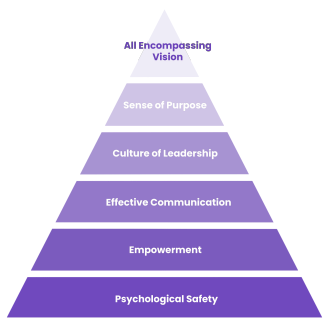How to Motivate Disengaged Employees?
Motivating disengaged employees can be achieved by implementing recognition programs and providing opportunities for growth and development. By acknowledging their efforts and offering paths for advancement, employees will be inspired to re-engage with their work and contribute to the overall success of the company.
Motivating employees is a crucial aspect of any successful organization. However, dealing with disengaged employees can be particularly challenging. When employees lose motivation, their productivity decreases and their enthusiasm wanes, leading to negative impacts on team dynamics and overall organizational performance.
Fortunately, there are effective strategies that can be employed to reinvigorate disengaged employees and bring out their full potential. We will explore some proven methods to motivate disengaged employees, leading to increased job satisfaction, productivity, and overall organizational success.
Understanding The Impact Of Disengaged Employees
Understanding the impact of disengaged employees is crucial in order to effectively motivate them. By implementing strategies that address their individual needs and providing opportunities for growth and recognition, companies can increase employee engagement and ultimately improve overall productivity and performance.
Employee disengagement can have a significant impact on a company’s overall performance and success. When employees are disengaged, they lack the motivation and commitment necessary to thrive in their roles. This can result in reduced productivity, poor job satisfaction, and high turnover rates.
To effectively motivate disengaged employees, it is crucial to understand the consequences of their disengagement, identify signs of disengagement, and explore the common causes of disengagement.
The Consequences Of Employee Disengagement:
- Decreased productivity: Disengaged employees often struggle to meet performance expectations, leading to a decline in overall productivity within the organization.
- Low employee morale: A disengaged employee can negatively impact the morale of the entire team, diminishing a positive work culture and camaraderie.
- High turnover rates: Disengaged employees are more likely to seek opportunities elsewhere, resulting in high turnover rates that can be costly and disruptive to the business.
- Reduced innovation: Disengagement can stifle creativity and innovation within a company, as employees lacking motivation may be reluctant to contribute fresh ideas or suggestions.
- Customer dissatisfaction: Disengaged employees may deliver subpar customer service, ultimately leading to dissatisfied customers and potential loss of business.
Identifying Signs Of Disengagement:
- Decreased participation: Disengaged employees may become less active in team meetings, discussions, or volunteering for additional tasks and responsibilities.
- Lack of enthusiasm: A loss of enthusiasm and a general lack of interest in work-related activities can be clear indicators of employee disengagement.
- Increased absences: Disengagement may lead to higher rates of absenteeism and ultimately affect productivity and team morale.
- Decline in quality of work: Disengaged employees may show a decline in the quality of their work, missing deadlines or paying less attention to detail.
- Lack of initiative: Disengagement often results in a lack of proactiveness, with employees failing to take the initiative or seek opportunities for growth and improvement.
Why Disengagement Occurs: Common Causes
- Poor communication: Lack of clear and effective communication from management can create a sense of disconnection and lead to employee disengagement.
- Limited growth opportunities: When employees feel that there are no avenues for advancement or professional development, they may become disengaged and demotivated.
- Micromanagement: Overbearing or micromanaging supervisors can hinder autonomy and job satisfaction, ultimately contributing to disengagement.
- Lack of recognition: Employees who feel undervalued or unappreciated for their contributions are more likely to become disengaged over time.
- Inadequate work-life balance: Excessive work demands or a lack of flexibility can lead to burnout and disengagement among employees.
Understanding the impact of disengaged employees, recognizing the signs of disengagement, and pinpointing the common causes can help organizations proactively address and mitigate this issue. In the following sections, we will explore effective strategies for motivating disengaged employees and fostering a more engaged and productive workforce.
Creating A Positive Work Environment
Motivating disengaged employees is crucial for creating a positive work environment. By offering recognition, providing opportunities for growth, and fostering open communication, organizations can inspire their team members to be more motivated and actively engaged in their work.
Fostering A Culture Of Trust And Transparency
Creating a positive work environment is crucial for motivating disengaged employees. By fostering a culture of trust and transparency, you can create an atmosphere where employees feel valued and supported. Here are some effective strategies to achieve this:
- Open communication: Encourage employees to voice their opinions, concerns, and suggestions openly. Foster a safe and inclusive environment where everyone feels comfortable expressing themselves.
- Transparent leadership: Be open and honest with your team. Share information about company goals, challenges, and decisions. Transparency builds trust and ensures that employees feel involved and informed.
- Recognize and appreciate: Show your appreciation for employees’ hard work and achievements. Regularly acknowledge their contributions and celebrate their successes. This helps foster a culture of recognition and reinforces a positive work environment.
- Lead by example: As a leader, exhibit the behaviors and values you want to see in your team. Demonstrate trustworthiness, integrity, and open communication yourself, setting the standard for others to follow.
Nurturing Effective Communication Channels
Effective communication is vital for employee engagement and motivation. Implementing clear and efficient communication channels helps foster a collaborative and productive work environment. Consider the following strategies:
- Regular team meetings: Conduct regular team meetings to keep everyone informed about current projects, goals, and challenges. This allows for open discussions, clarifications, and alignment among team members.
- Utilize technology: Invest in tools and software that facilitate communication, such as project management platforms, team chat applications, or video conferencing. Create a centralized space for sharing information and encouraging collaboration.
- Active listening: Promote active listening by providing opportunities for employees to share ideas, concerns, and feedback. Encourage open dialogue and consider implementing a suggestion box or regular feedback sessions.
- Promote collaboration: Create an environment where collaboration is encouraged and valued. Encourage cross-functional teamwork and provide opportunities for employees to work on joint projects, fostering communication and building relationships.
Promoting Work-Life Balance
Maintaining a healthy work-life balance is vital for employee well-being and motivation. Encourage and support your employees in achieving this balance to keep them engaged and avoid burnout. Consider implementing the following strategies:
- Flexible schedules: Offer flexible work hours or remote work options whenever possible. This allows employees to manage personal responsibilities and achieve a better work-life balance.
- Promote self-care: Encourage employees to prioritize self-care by taking breaks, incorporating exercise, and practicing stress-management techniques. Provide resources and initiatives that support their well-being.
- Fair workload distribution: Ensure that workloads are manageable and evenly distributed among team members. Avoid overloading individuals with excessive tasks and consider redistributing workload when necessary.
- Time-off policies: Implement generous time-off policies that allow employees to take breaks and vacations. Encourage their utilization and create a culture that values taking time to recharge.
By creating a positive work environment through trust and transparency, nurturing effective communication channels, and promoting work-life balance, you can significantly motivate disengaged employees and foster a more productive and engaged workforce.
Empowering Employees Through Recognition And Rewards
Recognizing and rewarding employees is the key to motivating disengaged workers, empowering them to contribute their best. By acknowledging their efforts and achievements, companies can boost morale, improve job satisfaction, and inspire a sense of belonging, resulting in increased productivity and a happier, more engaged workforce.
Motivating disengaged employees is a challenge faced by many organizations. One effective way to address this issue is by empowering employees through recognition and rewards. By implementing a performance-based reward system, recognizing and appreciating employee achievements, and providing opportunities for growth and development, organizations can boost employee engagement and motivation.
Let’s delve deeper into each of these strategies:
Implementing A Performance-Based Reward System
- Tie rewards directly to performance: Linking rewards to employee performance helps create a culture of accountability and motivation. It encourages employees to consistently strive for excellence.
- Set clear and measurable goals: Employees should have a clear understanding of what they need to achieve to earn rewards. By setting specific and measurable targets, employees can focus their efforts towards accomplishing those goals.
- Offer a variety of rewards: Provide a range of incentives that cater to different preferences and motivations. It could include financial bonuses, extra vacation days, gift cards, or even career advancement opportunities.
- Regularly review and update the reward system: Keep the reward system dynamic by periodically reviewing its effectiveness and making necessary adjustments. This ensures that it continues to inspire and motivate employees.
Recognizing And Appreciating Employee Achievements
- Provide timely feedback: Give employees regular feedback on their performance. Highlight their accomplishments and areas for improvement promptly, rather than waiting for lengthy performance reviews.
- Publicly acknowledge achievements: Recognize employee achievements through public channels such as emails, meetings, or company-wide announcements. This not only boosts the morale of the recognized employee but also inspires others to strive for similar success.
- Personalize recognition efforts: Tailor recognition to each individual’s preferences, whether it is a personal note, a small token of appreciation, or a public shout-out. Personalization shows that their efforts are valued and encourages continued engagement.
- Encourage peer-to-peer recognition: Foster a culture of appreciation where employees can recognize and appreciate each other’s achievements. This creates a positive work environment and strengthens team dynamics.
Providing Opportunities For Growth And Development
- Offer training and development programs: Provide employees with opportunities to enhance their skills and knowledge through workshops, seminars, or online courses. This not only helps them grow professionally but also signals that the organization values their individual growth.
- Assign challenging projects: Give employees the opportunity to take on challenging assignments that align with their interests and strengths. This not only keeps them engaged but also allows them to develop new skills and expand their capabilities.
- Support career progression: Provide clear pathways for career advancement within the organization. Offer mentoring programs, job rotation opportunities, or promotions based on individual performance and potential.
- Encourage innovation and creativity: Foster a culture that values and encourages new ideas and innovation. This empowers employees to take ownership of their work and contribute to the growth and success of the organization.
By implementing a performance-based reward system, recognizing and appreciating employee achievements, and providing opportunities for growth and development, organizations can inspire and motivate disengaged employees. Remember, a motivated workforce is critical for organizational success and employee satisfaction.
Building Strong Relationships And Effective Leadership
Discover effective strategies to motivate disengaged employees and build strong relationships through effective leadership. Learn how to inspire and empower your team to reach their full potential, leading to increased productivity and overall success.
Disengaged employees can be a real challenge for any organization, but there are strategies you can use to motivate them and boost their performance. One effective approach is to focus on building strong relationships and fostering effective leadership within your team.
In this section, we will explore two key aspects that can help you achieve this goal: encouraging open and honest feedback and cultivating strong relationships between managers and employees.
Encouraging Open And Honest Feedback
Encouraging open and honest feedback is vital to building strong relationships and fostering a positive work environment. When employees feel comfortable sharing their thoughts and opinions, it creates a sense of trust and collaboration. Here are some strategies to consider:
- Implement regular feedback sessions: Schedule regular one-on-one meetings with your employees to create a safe space for open dialogue.
- Create anonymous feedback channels: Provide anonymous feedback channels, such as suggestion boxes or online surveys, to give employees an opportunity to share their thoughts without fear of repercussions.
- Actively listen: When employees provide feedback, listen attentively. Show genuine interest and take their concerns seriously.
- Respond constructively: When addressing feedback, focus on finding solutions and taking appropriate actions. This demonstrates that their opinions are valued and can lead to a positive work environment.
Cultivating Strong Relationships Between Managers And Employees
Strong relationships between managers and employees are essential for employee engagement and motivation. When employees feel connected to their managers, they are more likely to be inspired and motivated to perform at their best. Here are some ways to cultivate strong relationships:
- Foster open communication: Encourage regular and transparent communication between managers and employees. This helps build trust and understanding.
- Provide mentorship opportunities: Encourage managers to be mentors and provide guidance and support to their team members. This helps employees feel supported and valued.
- Recognize and appreciate employees: Regularly acknowledge and appreciate employees’ efforts and accomplishments. This boosts morale and strengthens the manager-employee relationship.
- Lead by example: Managers should demonstrate the behavior they expect from their employees. This includes being respectful, transparent, and accountable.
By prioritizing open and honest feedback and cultivating strong relationships between managers and employees, organizations can create an environment that fosters motivation and engagement. These strategies can contribute to building effective leadership and inspiring employees to reach their full potential.
Keep in mind that every organization is unique, so adapt these approaches to fit your specific needs and culture.
Enhancing Employee Engagement Through Meaningful Work
Enhance employee engagement by providing meaningful work to motivate disengaged employees.
Employees who find their work meaningful are more likely to be motivated, engaged, and productive. By aligning employee values with the company’s mission, providing opportunities for personal and professional growth, and empowering employees with autonomy and responsibility, organizations can foster a sense of purpose and enhance employee engagement.
Aligning Employee Values With Company Mission:
- Ensure that employees understand and connect with the company’s mission, vision, and values.
- Encourage open and transparent communication to establish a strong alignment between individual values and organizational goals.
- Recognize and appreciate employees’ unique strengths and contributions to the company’s mission.
Providing Opportunities For Personal And Professional Growth:
- Offer continuous learning and development programs to enhance employees’ skills and knowledge.
- Provide mentorship and coaching opportunities to support career advancement.
- Create a culture of learning that encourages employees to take on new challenges and explore different roles within the organization.
Empowering Employees With Autonomy And Responsibility:
- Delegate decision-making authority to employees, allowing them to have a say in how their work is performed.
- Encourage creativity and innovation by giving employees the freedom to explore new ideas and approaches.
- Provide feedback and recognition to employees for their accomplishments and contributions.
Remember, when employees find their work meaningful, they are more likely to be engaged and motivated. By aligning employee values with the company’s mission, providing opportunities for personal and professional growth, and empowering employees with autonomy and responsibility, organizations can enhance employee engagement and create a more productive workforce.

Credit: empxtrack.com
Utilizing Technology For Employee Engagement
Discover how technology can be leveraged to engage and motivate disengaged employees, improving their productivity and job satisfaction. Explore innovative solutions and strategies to create a positive work environment that drives employee engagement and boosts overall organizational success.
Leveraging Digital Tools For Efficient Communication:
- Embracing digital communication tools such as instant messaging and email to foster quick and effective communication among employees.
- Utilizing project management software to assign tasks, set deadlines, and track progress, ensuring efficient collaboration within teams.
- Implementing video conferencing tools for virtual meetings and presentations, enabling seamless communication regardless of geographical limitations.
- Using online survey tools to gather feedback and opinions from employees, promoting active engagement and providing a platform for open communication.
- Leveraging internal communication platforms and forums to foster a sense of community and encourage knowledge sharing among employees.
Enhancing Collaboration Through Remote Work Solutions:
- Utilizing cloud-based collaboration tools to enable remote employees to access and work on shared documents in real-time.
- Empowering employees with remote access to company resources and files, allowing for uninterrupted collaboration and productivity.
- Encouraging the use of virtual project management tools, enabling teams to collaborate, share ideas, and work on tasks from anywhere in the world.
- Establishing virtual team building activities and online social platforms to strengthen the bonds between remote employees and increase overall engagement.
- Providing training and support for remote work solutions to ensure employees are equipped with the necessary skills and knowledge to collaborate effectively from remote locations.
Using Data Analytics To Gain Insights And Make Informed Decisions:
- Implementing employee monitoring software to track productivity levels, identify areas for improvement, and address potential disengagement issues.
- Analyzing data from employee satisfaction surveys to understand areas of dissatisfaction and develop targeted strategies to improve employee engagement.
- Utilizing data analytics tools to analyze patterns in employee performance and behavior, identifying key areas for motivation and recognition.
- Leveraging data to identify high-potential employees and provide them with growth opportunities and career development plans.
- Developing data-driven employee reward and recognition programs to acknowledge and appreciate employees’ contributions, fostering motivation and engagement.
Remember, employee engagement is crucial for a productive and thriving workplace. By leveraging digital tools for efficient communication, enhancing collaboration through remote work solutions, and using data analytics to gain insights, organizations can effectively motivate disengaged employees and create a positive work environment.
Overcoming Challenges And Obstacles
Motivating disengaged employees to overcome challenges and obstacles can be achieved by implementing effective communication, setting clear expectations, recognizing achievements, and providing opportunities for growth and development. By empowering employees and fostering a positive work environment, organizations can inspire their workforce to overcome obstacles and achieve their full potential.
Dealing With Resistance To Change
- Even the most well-intentioned change initiatives can meet resistance from employees. Here are some ways to handle resistance to change:
- Communicate the purpose and benefits of the change clearly to the disengaged employees so they can understand why it is necessary.
- Provide training and resources to support employees in adapting to the change, reducing their fear of the unknown.
- Involve employees in the decision-making process to make them feel valued and included.
- Address concerns and provide reassurance about job security and future opportunities.
- Offer incentives or rewards for embracing and participating in the change.
Addressing Burnout And Stress
- When employees are disengaged, burnout and stress can often be contributing factors. Here’s how to address these challenges:
- Encourage work-life balance and set clear boundaries between work and personal life to prevent burnout.
- Provide opportunities for breaks, relaxation, and wellness activities to help reduce stress levels.
- Offer stress management workshops or programs to equip employees with effective coping mechanisms.
- Foster a supportive and inclusive work environment where employees feel comfortable discussing their challenges and seeking help.
- Allocate workloads and deadlines in a fair and manageable manner to alleviate excessive pressure.
Handling Conflicts And Fostering Teamwork
- Conflicts and lack of teamwork can hinder employee engagement. Here’s how to address these obstacles:
- Encourage open communication and active listening to resolve conflicts before they escalate.
- Implement conflict resolution training to equip employees with conflict management skills.
- Foster a collaborative work culture by creating opportunities for team building activities and projects.
- Promote diversity and inclusion within teams to enhance creativity and problem-solving.
- Recognize and reward collaborative efforts, encouraging employees to work together towards common goals.
Remember, overcoming challenges and obstacles requires a proactive approach. By addressing resistance to change, burnout and stress, conflicts, and fostering teamwork, you can effectively motivate disengaged employees and create a more engaged and productive workforce.
Measuring And Evaluating Employee Engagement
Discover effective strategies for measuring and evaluating employee engagement to better understand and motivate disengaged employees. Gain insights into the key factors that impact employee satisfaction and learn how to create a positive and engaging work environment.
Several methods can be used to measure and evaluate employee engagement within an organization. These techniques help identify areas of improvement and develop strategies to motivate disengaged employees. Here are two effective approaches:
Utilizing Employee Surveys And Feedback Mechanisms:
- Conducting regular employee surveys can provide valuable insights into the level of engagement within the organization.
- Encourage employees to provide honest feedback through anonymous surveys to ensure their opinions are heard without fear of repercussions.
- Surveys should cover various aspects of employee engagement, such as job satisfaction, communication, growth opportunities, and work-life balance.
- Analyze survey results to identify common themes and areas of improvement.
- Use feedback mechanisms such as suggestion boxes or online forums to gather continuous feedback from employees.
- Actively listen to employee suggestions and take concrete steps to address their concerns.
Analyzing Key Engagement Metrics And Indicators:
- Measure key engagement metrics such as employee turnover rate and absenteeism. A high turnover rate or increased absenteeism can indicate low employee engagement.
- Look for patterns or trends in employee performance reviews. Decreasing productivity or declining quality of work may suggest disengagement.
- Monitor employee participation in training programs and professional development opportunities. A lack of interest or participation could signify disengagement.
- Analyze employee satisfaction scores and feedback from performance appraisals. Use this data to identify specific areas where engagement is lacking.
Tracking progress and adjusting strategies as needed is crucial to maintaining employee engagement. Here are some strategies:
- Set specific goals and objectives for improving employee engagement based on the survey results and key metrics.
- Implement initiatives and programs that address the identified areas of improvement.
- Regularly measure and track the impact of these initiatives on employee engagement.
- Encourage ongoing communication with employees to gather feedback on the effectiveness of implemented strategies.
- Make necessary adjustments to the engagement strategies based on the feedback received.
By utilizing employee surveys, analyzing key engagement metrics, and actively tracking progress, organizations can gain valuable insights into employee engagement and take necessary steps to motivate disengaged employees. Engaged employees are more likely to be productive, satisfied, and committed to their organization, leading to a positive work environment and improved overall performance.
Taking Action: A Step-By-Step Guide To Motivating Disengaged Employees
Discover the actionable steps you need to motivate disengaged employees with “Taking Action: A Step-by-Step Guide to Motivating Disengaged Employees. ” This comprehensive guide provides practical strategies and insights to inspire and engage your team for improved productivity and morale.
Disengaged employees can be a challenge for any organization, as their lack of motivation and commitment can lead to decreased productivity and overall dissatisfaction. However, with the right strategies in place, it is possible to re-engage and motivate these individuals.
This step-by-step guide will outline how to identify the root causes of disengagement, create an action plan for improvement, and implement strategies to monitor progress.
Identifying The Root Causes Of Disengagement
To effectively motivate disengaged employees, it is crucial to first understand the underlying reasons behind their lack of engagement. Here are some key steps to help in identifying the root causes:
- Conduct employee surveys or interviews to gather insights and feedback.
: This provides employees with a platform to share their concerns openly and allows management to gain a deeper understanding of the issues at hand.
- Analyze employee performance and behavior data to identify patterns.
: This can help identify trends or common factors contributing to disengagement, such as a lack of recognition, inadequate communication, or limited growth opportunities.
- Encourage open dialogue and establish strong communication channels.
: Providing regular opportunities for employees to voice their concerns and share their ideas can help identify any underlying issues that may be impacting their engagement.
Creating An Action Plan For Improvement
Once the root causes of disengagement have been identified, it is important to develop a clear action plan to address these issues. Consider the following steps:
- Set clear and measurable goals for improvement.
: Having specific targets in mind will help keep the focus on driving change and measuring progress.
- Establish a cross-functional team to drive the initiative.
: This team should consist of representatives from various departments to ensure a holistic approach to resolving the issues.
- Develop targeted interventions and initiatives.
: Identify specific actions and programs that will directly address the identified root causes of disengagement. For example, implementing a recognition program to address the lack of appreciation or introducing training and development opportunities to address growth concerns.
Implementing Strategies And Monitoring Progress
Implementing the action plan is a crucial step in re-engaging disengaged employees. Use the following strategies to ensure successful implementation and ongoing monitoring:
- Communicate the action plan to all employees.
: Transparency is key in ensuring that everyone understands the plan, their roles, and the expected outcomes.
- Provide necessary resources and support.
: Ensure that employees have access to the resources they need to implement the required changes, whether it’s additional training, mentorship programs, or updated systems.
- Assign responsibility and accountability.
: Clearly define roles and responsibilities within the team to ensure that progress is being made and that all actions are being carried out as planned.
- Continuously monitor and evaluate progress.
: Regularly assess the impact of the implemented strategies, gather feedback from employees, and make adjustments as needed.
By following these steps, organizations can take proactive measures to motivate disengaged employees and create a more positive and productive work environment. Understanding the root causes, creating an action plan, and implementing targeted strategies will help re-engage employees and drive overall success.
Success Stories: Real-Life Examples Of Motivating Disengaged Employees
Discover real-life success stories that offer practical examples on how to motivate disengaged employees. These inspiring narratives provide valuable insights and strategies for unlocking the potential of your team through effective motivational techniques.
Case Studies Showcasing Successful Employee Engagement Initiatives
- XYZ Company: From Disengaged to Thriving: XYZ Company implemented a mentorship program where senior employees were paired with junior staff members, providing guidance, support, and fostering a sense of belonging. This initiative resulted in increased employee engagement and a significant boost to productivity.
- ABC Corporation: The Power of Recognition: ABC Corporation introduced an employee recognition program that rewarded outstanding performance. Employees who exceeded their targets were publicly acknowledged, boosting their morale and motivation levels. This recognition initiative led to reduced turnover rates and a more engaged workforce.
- DEF Enterprises: Embracing a Flexible Work Culture: DEF Enterprises implemented flexible work policies, allowing employees to have more control over their work schedules. This initiative empowered employees to better balance their personal and professional commitments, leading to higher job satisfaction and increased productivity.
Lessons Learned From Companies That Have Overcome Disengagement
- Clear Communication is Key: Companies that successfully addressed employee disengagement prioritized transparent and effective communication channels. Regular updates, town hall meetings, and open-door policies created a sense of trust and inclusion among employees.
- Invest in Training and Development: Organizations that invested in training and development programs saw a significant improvement in employee engagement levels. Providing opportunities for skill enhancement and career growth demonstrated a commitment to employee success, leading to increased motivation and loyalty.
- Encourage Collaboration and Teamwork: Companies that fostered a collaborative work environment and encouraged teamwork experienced higher levels of employee engagement. Creating cross-functional teams and encouraging the sharing of ideas and knowledge helped employees feel valued and engaged in their work.
Inspirational Stories Of Employees Who Turned Their Engagement Around
- From Burnout to Passion: Jane’s Story: Jane, a marketing executive, was disengaged and on the verge of burnout. However, after attending a motivational conference, she realized the importance of work-life balance and self-care. Jane took proactive steps to prioritize her well-being, leading to increased job satisfaction and renewed passion for her work.
- Bob’s Transformation: Finding Purpose in Work: Bob, a software engineer, felt disconnected from his role and lacked motivation. However, after attending a company-wide workshop on the impact of their work, Bob realized the significance of his contributions. This newfound sense of purpose reinvigorated his engagement and fueled his determination to excel in his role.
- Sara’s Journey: Empowered and Engaged: Sara, a customer service representative, felt unfulfilled and disengaged. However, after her supervisor identified her strengths and provided opportunities for growth, Sara’s confidence soared. She became a valuable asset to the company, developing strong relationships with customers and contributing to the organization’s success.
Remember, employee engagement is crucial for organizational success. By implementing successful initiatives, learning from case studies, and inspiring employees to turn their engagement around, companies can create a thriving work environment where employees feel motivated, valued, and committed.
Frequently Asked Questions Of How To Motivate Disengaged Employees
How Do You Fix Disengagement At Work?
To fix disengagement at work, focus on clear communication, recognition of employees’ efforts, providing growth opportunities, and fostering a positive work culture.
How Do You Engage A Disengaged Person?
To engage a disengaged person, show genuine interest, listen actively, ask open-ended questions, and provide relevant solutions.
What Is The Root Cause Of Disengaged Employees?
Disengaged employees are often caused by lack of motivation, unclear goals, poor communication, and inadequate recognition.
How Do You Solve Lack Of Employee Engagement?
Increase employee engagement by providing regular feedback, creating a supportive work culture, offering meaningful recognition, and promoting open communication.
Conclusion
Motivating disengaged employees requires a multifaceted approach that begins with understanding the underlying reasons for their disengagement. By fostering open communication, providing recognition and rewards, offering opportunities for growth and development, and creating a positive work environment, employers can inspire their employees to become more engaged and committed to their work.
Additionally, implementing team-building activities and encouraging a healthy work-life balance can further boost employee morale and motivation. Remember, each employee is unique, so taking the time to understand their individual needs and motivations is key. By investing in the well-being and engagement of your employees, you can create a thriving workplace culture that not only benefits your team but also your business as a whole.
So, start implementing these strategies today and watch the transformation unfold.



